8下仁爱英语教学案例设计 unit 7T1(p1)
- 格式:doc
- 大小:47.98 KB
- 文档页数:13
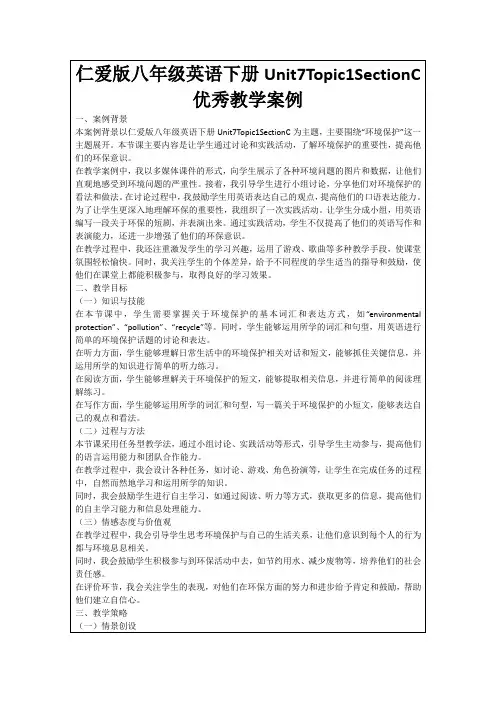
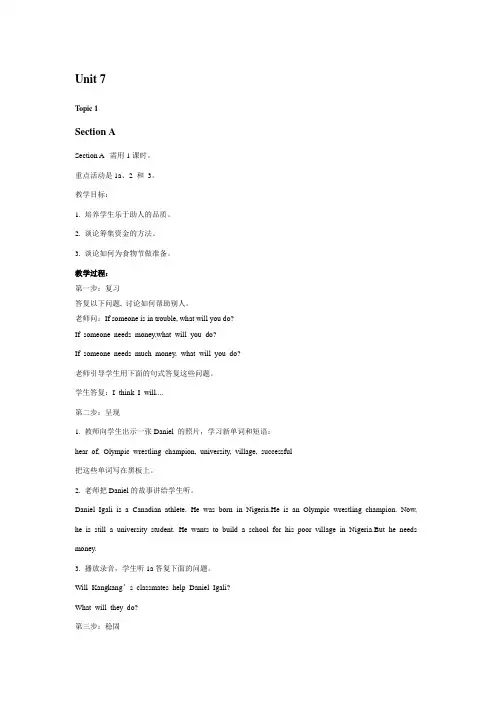
Unit 7Topic 1Section ASection A 需用1课时。
重点活动是1a、2 和3。
教学目标:1. 培养学生乐于助人的品质。
2. 谈论筹集资金的方法。
3. 谈论如何为食物节做准备。
教学过程:第一步:复习答复以下问题, 讨论如何帮助别人。
老师问:If someone is in trouble, what will you do?If someone needs money,what will you do?If someone needs much money, what will you do?老师引导学生用下面的句式答复这些问题。
学生答复:I think I will....第二步:呈现1. 教师向学生出示一张Daniel 的照片,学习新单词和短语:hear of, Olympic wrestling champion, university, village, successful把这些单词写在黑板上。
2. 老师把Daniel的故事讲给学生听。
Daniel Igali is a Canadian athlete. He was born in Nigeria.He is an Olympic wrestling champion. Now, he is still a university student. He wants to build a school for his poor village in Nigeria.But he needs money.3. 播放录音,学生听1a答复下面的问题。
Will Kangkang’s classmates help Daniel Igali?What will they do?第三步:稳固1. 播放录音,让学生跟读并模仿。
2. 读1a对话,完成1b。
3. 两人一组活动,老师把重点句型写在黑板上,让学生看着表演1a的对话。
完成1c。
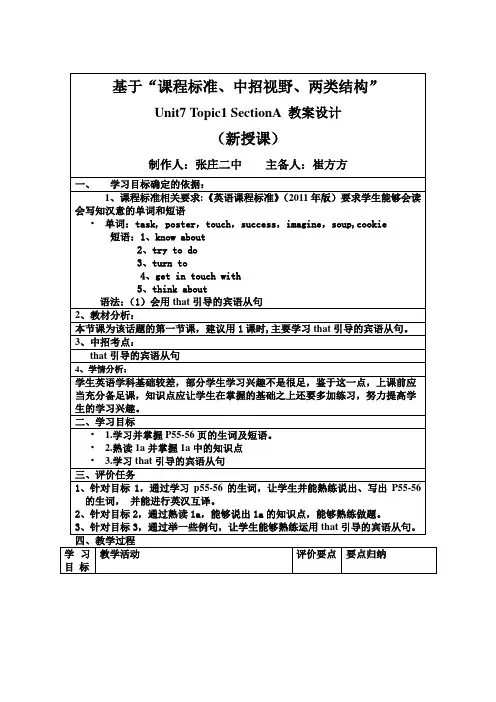


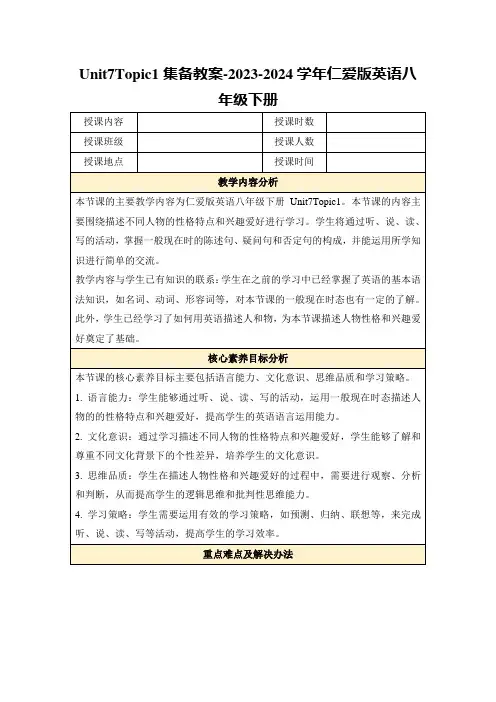
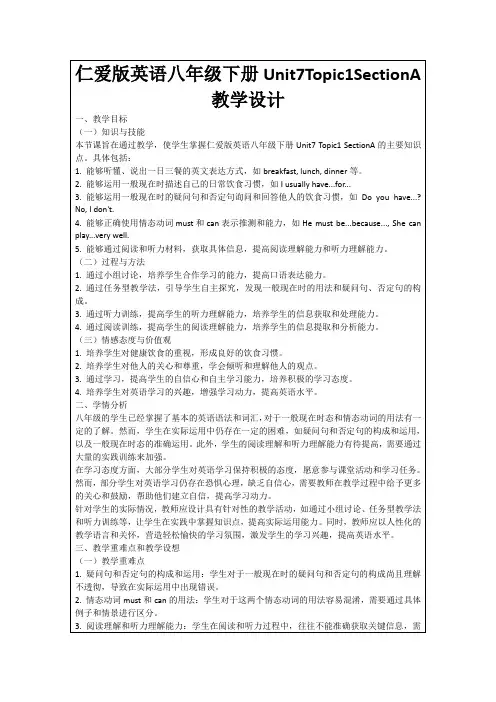
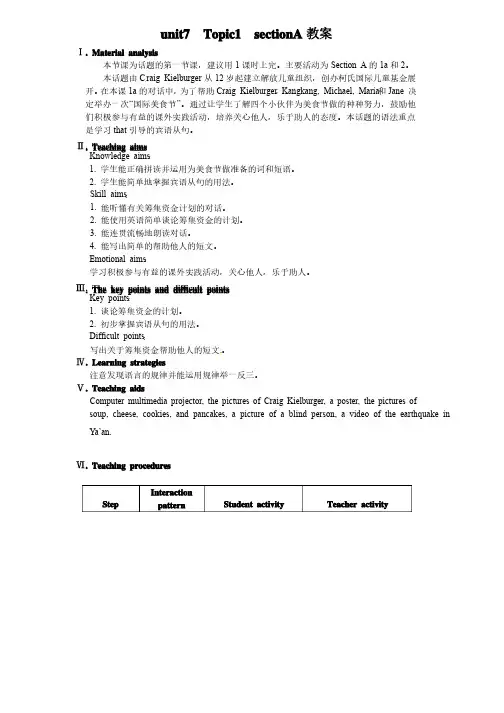
unit7 Topic1 sectionA 教案Ⅰ. Material analysis本节课为话题的第一节课,建议用1课时上完。
主要活动为Section A 的1a 和2。
本话题由C raig Kielburger 从12岁起建立解放儿童组织,创办柯氏国际儿童基金展开。
在本课1a 的对话中,为了帮助Craig Kielburger ,Kangkang, Michael, Maria 和Jane 决定举办一次“国际美食节”。
通过让学生了解四个小伙伴为美食节做的种种努力,鼓励他们积极参与有益的课外实践活动,培养关心他人,乐于助人的态度。
本话题的语法重点是学习that 引导的宾语从句。
Ⅱ. Teaching aims Knowledge aims :1. 学生能正确拼读并运用为美食节做准备的词和短语。
2. 学生能简单地掌握宾语从句的用法。
Skill aims :1. 能听懂有关筹集资金计划的对话。
2. 能使用英语简单谈论筹集资金的计划。
3. 能连贯流畅地朗读对话。
4. 能写出简单的帮助他人的短文。
Emotional aims :学习积极参与有益的课外实践活动,关心他人,乐于助人。
Ⅲ. The key points and difficult points Key points :1. 谈论筹集资金的计划。
2. 初步掌握宾语从句的用法。
Difficult points :写出关于筹集资金帮助他人的短文。
Ⅳ. Learning strategies注意发现语言的规律并能运用规律举一反三。
Ⅴ. Teaching aidsComputer Computer multimedia multimedia multimedia projector, projector, projector, the the the pictures pictures pictures of of of Craig Craig Craig Kielburger, Kielburger, Kielburger, a a a poster, poster, poster, the the the pictures pictures pictures of of soup, cheese, cookies, and pancakes, a picture of a blind person, a video of the earthquake in Ya’an.Ⅵ. Teaching proceduresStep Interaction patternStudent activity Teacher activityIntroduction (8 minutes)1. The whole class work. 2. The whole class work. 3. Group work. 4. The whole class work. 5. The whole class work. 1. Focus their attention on the teacher. 2. Students read the passage passage about about about the the the traffic traffic rules rules they they they made made made after after class. 3. Students discuss in groups and ans w er the wer the questions with the structure: I think Iwill…4. Students learn and grasp the new words and phrases with the help of the teacher. 5. Students report the information about Craig Kielburger they collected. 1. Greet students ready for learning. 2. Teacher asks the students to to report report report the the the homework. homework. Let Let the the the students students students read read read the the passage passage about about about the the the traffic traffic rules they made after class. 3. Teacher asks the students to think about the following questions: If someone isin trouble, what will youdo? If someone needs money,what will you do? Then ask the studen ts to answer them with the structure: I think I will…4. 4. Teacher Teacher Teacher teaches teaches teaches the the the new new words by summing up the answers above: “Now Now I I I see, see, see, some some some students students will turn to their their parents, parents, which means they will ask their parents for help. Some students imaginethat they can put on a play to to raise raise raise money. money. money. Y ou Y ou can can try your best to help others, others, I’m I’m I’m so so so proud proud proud of of you!”5. 5. Teacher Teacher Teacher shows shows shows the the the pictures pictures o f Craig Kielburger to the students. Ask the students to to report report report the the the information information about Craig Kielburger they collected. Presentation (10 minutes) 1. The whole class work. 2. Individual work. 3. The whole class work. 4. Individual work. 5. The whole class work. 6. The whole class work. 7. Individual work. 8. The whole class work. 9. Individual work. 10. The whole class work. 1. Students look at the picture of 1a, and understand understand the the the picture picture with the help of the information under it. 2. Students watch the flash, and then mark the sentences of 1b wi th T or F. 3. Students check the answers. 4. Students read the conversation and match the information of 1c. 5. Students check the answers. 6. Students read the sentences aloud. 7. Students find out the same same structure structure structure in in in the the sentences of 1c. 8. Students check the answers. 9. Students watch the flash flash and and and answer answer the questions. 10. Students check the answers. 1. T eacher praises students’ information they collected after after class. class. class. Encourage Encourage Encourage them them to keep on making a preview before before class. class. class. Then Then Then let let let the the students students look look look at at at the the the picture picture of of 1a 1a 1a and and and undund erstand erstand the the picture picture with with with the the the help help help of of of the the information under it. 2. Teacher plays the flash of 1a. Ask the students to watch watch the the the flash, flash, flash, and and and then then mark mark the the the sentences sentences sentences of of of 1b 1b with T or F. 3. Teacher asks two students to tell the answers. 4. Teacher asks the students to to read read read the the the conversation conversation and match the information of 1c. 5. Teacher asks two students to tell the answers.6. Teacher asks the students to read the sentences aloud. 7. Teacher asks the students to find out the same structure in the sentences of 1c. 8. Teacher asks two students to tell the answers. 9. Teacher asks the students to watch the flash again and answer the following questions: (1) How many schools did Free the Children build? (2) What’s Michael’s task?10. Teacher asks two students to tell the answers. Teach the new word p osterposter by showing a real poster to them. Consolidation (10 minutes) 1. The whole class work. 2. The whole class work. 3. Group work. 4. The whole class work. 5. Group work. 6. The whole class work. 7. The whole class work. 1. Students read the conversation after the recording sentence by sentence. 2. Students try to follow the speed, paying attention to the pronunciation and intonation. 3. Students discuss in groups groups to to to find find find out out out the the difficult difficult points points points and and and sum sum up the main points. 4. 4. Students Students Students underline underline underline in in their books and make some notes. Learn and grasp grasp the the the new new new words words and phrases. 5. Students discuss in groups: What will the food festival be like? 6. V olunteers report the result of the discussion. 7. Students act out the conversation of 1a. 1. Teacher plays the recording sentence by sentence. 2. Teacher plays the recording without stopping. 3. Teacher asks the students to learn in groups to find out the difficult points in the conversation. At last let them sum up the main points of the conversation. 4. 4. T eacher T eacher makes makes makes a a a summary summary to to explain the key points and explain the key points and difficult points to the students. (1) have/hold/ organize a food festival (2) turn to sb. /ask sb. for help (3) make a poster (4) get in touch with sb. (5) try one’s best to do sth. (6) make it a success (7) 由that 引导的宾语从句引导的宾语从句5. T eacher lets the students read 1a, and then discuss what the food festival will be like with the the help help help of of of the the the pictures pictures pictures and and the example. Let them practice the usage of the object clauses. 6. Teacher asks four students to report the result of the discussion. Finish 1d. 7. T eacher asks the students to act out the conversation of 1a. Practice (10 minutes) 1. The whole class work. 2. Group work. 3. Individual work. 4. The whole class work. 5. Pair work. 6. Individual work. 7. The whole class work. 1. Students learn and grasp the new words with the help of the teacher. 2. Students discuss what the children children should should should prepare prepare for for the the the food food food festival festival festival in in groups. 3. Students write down the conversations. 4. Students evaluate the conversations, conversations, and and and then then check check the the the answers answers answers with with the teacher. 5. Students act out the conversations in pairs. 6. Students listen and match match the the the people people people with with what we can do. 7. Students check the answers. 1. Teacher teaches the new words soup, cheese, cookies,and pancakes by by showing showing their pictures on the screen. Teach set and set the tableby explaining their Chinese meaning. 2. Teacher asks the students to discuss what the children should prepare for the food festival. 3. Teacher asks four students to write down the conversations on the blackboard. The other students write down at least two conversations in their each workbook. 4. 4. Teacher Teacher Teacher lets lets lets two two two or or or three three students evaluate the conversations on the blackboard. Check the answers. 5. Teacher lets the students act act out out out the the the conversations conversations in pairs. 6. 6. Teacher plays the recording Teacher plays the recording of of 3 3 3 for for for the the the students students students and and lets the students listen and match the people with what we can do. 7. 7. Teacher Teacher Teacher lets lets lets two two two students students tell tell their their their answers. answers. answers. Teach Teach blind by showing a picture of a blind person. Production (7 minutes) 1. Group work. 2. The whole class work. 3. The whole class work. 4. The whole class work. 5. Individual work. 1. Students watch the video and discuss in groups. 2. Students write down their opinions with the structure I think…3. Students share their opinions with with the the whole class. 4. Students summarize Section A with the teacher. 5. Students finish the homework after class. 1. Teacher plays the video of the Ya’an earthquake. Lead the students to discuss in groups: “A terr“A terrible earthquake ible earthquake struck Ya’an in Sichuan Province at 8: 02 on the morning of April 20th this year. Le t’s discuss how to help the p eople in Ya’an.”people in Ya’an.”2. Teacher asks the students to write down their opinions with the structure Ithink…3. Teacher asks four students from different groups to share their opinions. Tell them that we should try our best to help the people in trouble. 4. Teacher shows the summary of this section to the students. 5. Teacher assigns homework: (1) Review the summary after class. (2) Write down a passage about how to help the the people people people in in in Y Y a’an with the sentences containing object clauses. (3) Search some typical foods in different countries to prepare for Section B. Teaching Reflection The students a dmire Craig Kielburger very much. It’s a successful admire Craig Kielburger very much. It’s a successful lesson: lesson: The The The students students students want want want to to to learn learn learn from from from him him him to to to help help help the the the people people people in in trouble. The teacher should introduce more information of Craig Kielburger to the students to encourage them to help others from now on. Ⅶ. Blackboard designUnit 7 Food Festival Topic 1 We’re preparing for a food festival. Section A 1. have/hold/ organize a food festival 2. turn to sb. /ask sb. for help 3. make a poster 4. get in touch with sb. 5. try one’s best to do sth.6. make it a success 7. Kangkang knows (that) Graig comes from Canada. 8. set the table 。
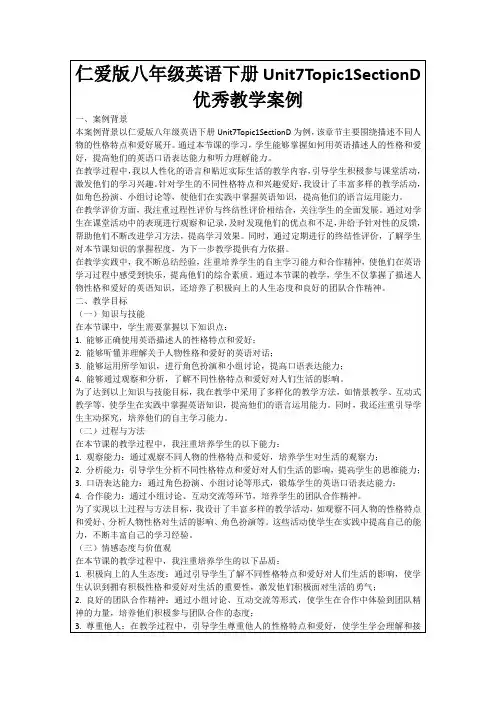

Unit7Food FestivalTopic1 We’re preparing for the food festivalSectionA重庆市巴南区鱼洞南区学校周静Background Infromation:School: Yudong Nanqu SchoolTeacher: Zhou JingStudents: Grade 8Type of lesson: Listening and speaking classTeaching aids: video, pictures, colored cardsTeaching aims1.Knowledge aims:1)Be able to understand, read and use key vocabulary.2)Get to know objective clauses.2.Skill aims:1)Be able to apply mind-map to sum up the main content of a text.2)Underline key words in the title before listening3)Be able to use objective clauses to express ideas or wishes.3.Culture awareness:Get to know Craig Kielburger and Free the Children. Cultivate students’ care for poor children in the world.4.Emotional aims:1)Students are confident to express their own ideas and be able to coperate with others.2)Students are inspired to care for others and start from little things.Key and difficult points1.Key points:1)Key vocabulary: food festival, poster, task, turn to sb, get in touch with, make it a success2)I think/believe/know/imagine/hope that...2.Difficult points:1)Person transformation2)Statement transformationTeaching procedureStage1: Warming-up1.Watch a video about food festival before the class.2.Greetings and lead the study of learn words.Stage2: Pre-listeningTask1: Learn new words and practice “I know/believe/think/hope that...”Task2: Doughnut competitionTask3: Culture background.1.Watch a video about Craig Kielburger and ask questions.2.Enjoy a poem about Craig Kielburger.Stage3: While-listeningTask1: Listen to 1a and choose the right answer.Task2: Mark T or F.Stdents learn to underline key words before listening and pay attention to tense, numbers and degree adverbs.Stage4: Post-listeningTask1: Read in rolesStudents in different groups represent different roles and read 1a.Task2: What can you imagine?Use sentence structure“I imagine that” to imagine what their food festival will be like Task3: Complete the mind-map of 1aStage5: ProjectTask: Draw a poster to ask people to care for left-behind children.1.Discuss ways to help left-behind children.2.Group work: design, draw and write down how to help them with the sentence structures: I think/believe/know/hope/imagine (that)...3.PresentationStage6: Summary1.The teacher sums up the key points and main sentence structures “ Ithink/believe/know/hope/imagine (that)...”2.Put the posters made by students into a big tree. “If everyone gives a helping hand, we will have a better world.Stage7: Homeworkplete the mind-map about how to help left-behind children.2.Retell 1a by key words3.ExercisesBlackboard design。
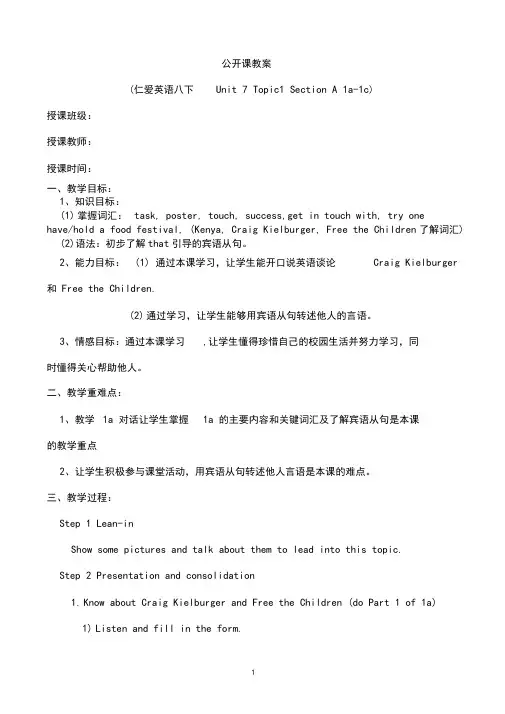
公开课教案(仁爱英语八下Unit 7 Topic1 Section A 1a-1c)授课班级:授课教师:授课时间:一、教学目标:1、知识目标:(1)掌握词汇:task, poster, touch, success,get in touch with, try onehave/hold a food festival, (Kenya, Craig Kielburger, Free the Children了解词汇)(2)语法:初步了解that引导的宾语从句。
2、能力目标:(1) 通过本课学习,让学生能开口说英语谈论Craig Kielburger 和Free the Children.(2)通过学习,让学生能够用宾语从句转述他人的言语。
3、情感目标:通过本课学习,让学生懂得珍惜自己的校园生活并努力学习,同时懂得关心帮助他人。
二、教学重难点:1、教学1a 对话让学生掌握1a 的主要内容和关键词汇及了解宾语从句是本课的教学重点2、让学生积极参与课堂活动,用宾语从句转述他人言语是本课的难点。
三、教学过程:Step 1 Lean-inShow some pictures and talk about them to lead into this topic.Step 2 Presentation and consolidation1.Know about Craig Kielburger and Free the Children (do Part 1 of 1a)1)Listen and fill in the form.2)Read and answer the questions.3)Listen and repeat the dialogue and explain it briefly.4)Retell the main idea of this small dialogue by filling the blanks.2.Know about the Food Festival (do Part 2 of 1a)1)Show a picture and say “ They try to build a school in Kenya. But they don have enough money. ”2)Talk about “ how to raise money to help them? ” Then lead to Part2 of1a.3)Listen and answer the questionWhat will Kangkang and his friends do to help them raise money?4)Read the dialogue and match their tasks for the food festival.5)Read the dialogue and repeat to try to remember their tasks .6)Fill in the blanks7)Read the whole dialogue together3.Learn the grammar --- Object Clauses1)Lead in by asking and answeringWhat does Kangkang say? (Craig is from Canada.)f He says Craig is from Canada.What does Maria say? (Free the Children has built over 700 school rooms in many countries.)— She says Free the Children has built over 700 school rooms in many countries.What does Jane say? (Young people raised most of the money.)一 She says young peopl毋aised most of the money.2)Explain and sum up the Object Clauses.4.Exercise and practice.Step 3 Make more sentences with object clause to talk about how to help poor people.If you have a chance to help poor people, what will you do for them?For example: I think I will...Step 4 Summary and Homework.Summary:1.Some new words: task, poster, touch, success ,2.Some newphrases: turn to, get in touch with, try one ' s best,have/hold a food festival, make a poster3.Object clauses guided by that1).Maria says she will turn to their teachers.2).Michael says his task is to make a poster.3).She says she will think about how to hold the food festival.4.Know sth about Craig Kielburger and Free the Children, and talk about how to help poor people.Homework:1.熟读生词及短语并抄写在作业本上(3遍).2.熟读课文1a对话3遍以上.3.完成导学案第5题4.完成《同步练习》SA.四、板书设计:Unit 7 Topic 1 Section AWords and phrases:turn toFree the ChildrenCraig KielburgerKenyatry one s besthave a food festivaltaskposter --- make a postertouch --- get in touch withsuccess —— make it a success五、教学总结及反思本节课主要是让学生谈论Craig Kielburger及他的组织Free the Children学习本课相关的词汇和语法宾语从句。
公开课教案(仁爱英语八下Unit 7 Topic1 Section A 1a-1c)授课班级:授课教师:授课时间:一、教学目标:1、知识目标:(1)掌握词汇:task, poster, touch, success,get in touch with, try one’s best, turn to, have/hold a food festival, (Kenya, Craig Kielburger, Free the Children了解词汇) (2)语法:初步了解that引导的宾语从句。
2、能力目标:(1) 通过本课学习,让学生能开口说英语谈论Craig Kielburger 和Free the Children.(2) 通过学习,让学生能够用宾语从句转述他人的言语。
3、情感目标:通过本课学习,让学生懂得珍惜自己的校园生活并努力学习,同时懂得关心帮助他人。
二、教学重难点:1、教学1a对话让学生掌握1a的主要内容和关键词汇及了解宾语从句是本课的教学重点2、让学生积极参与课堂活动,用宾语从句转述他人言语是本课的难点。
三、教学过程:Step 1 Lean-inShow some pictures and talk about them to lead into this topic.Step 2 Presentation and consolidation1. Know about Craig Kielburger and Free the Children (do Part 1 of 1a)1) Listen and fill in the form.2) Read and answer the questions.3) Listen and repeat the dialogue and explain it briefly.4) Retell the main idea of this small dialogue by filling the blanks.2. Know about the Food Festival (do Part 2 of 1a)1) Show a picture and say“They try to build a school in Kenya. But they don’t have enough money.”2) Talk abou t “how to raise money to help them?” Then lead to Part2 of 1a.3) Listen and answer the questionWhat will Kangkang and his friends do to help them raise money?4) Read the dialogue and match their tasks for the food festival.5) Read the dialogue and repeat to try to remember their tasks .6) Fill in the blanks7) Read the whole dialogue together3. Learn the grammar --- Object Clauses1) Lead in by asking and answeringWhat does Kangkang say? (Craig is from Canada.)→ He says Craig is from Canada.What does Maria say? (Free the Children has built over 700 school rooms in many countries.)→She says Free the Children has built over 700 school rooms in many countries.What does Jane say? (Young people raised most of the money.)→ She says young people raised most of the money.2) Explain and sum up the Object Clauses.4.Exercise and practice.Step 3 Make more sentences with object clause to talk about how to help poor people.If you have a chance to help poor people, what will you do for them?For example: I think I will...Step 4 Summary and Homework.Summary:1.Some new words: task, poster, touch, success ,2.Some new phrases: turn to, get in touch with, try one’s best,have/hold a food festival, make a poster3. Object clauses guided by that1).Maria says she will turn to their teachers.2).Michael says his task is to make a poster.3).She says she will think about how to hold the food festival.4.Know sth about Craig Kielburger and Free the Children, and talk about how to help poor people.Homework:1.熟读生词及短语并抄写在作业本上(3遍).2.熟读课文1a对话3遍以上.3.完成导学案第5题4.完成《同步练习》SA.四、板书设计:五、教学总结及反思本节课主要是让学生谈论Craig Kielburger及他的组织Free the Children,学习本课相关的词汇和语法宾语从句。
仁爱版英语八下Unit 7 Topic 1 Section A 精品教学设计Ⅰ. Material analysis本节课为话题的第一节课,建议用1课时上完。
主要活动为Section A 的1a和2。
本话题由Craig Kielburger 从12岁起建立解放儿童组织,创办柯氏国际儿童基金展开。
在本课1a的对话中,为了帮助Craig Kielburger,Kangkang, Michael, Maria 和Jane 决定举办一次“国际美食节”。
通过让学生了解四个小伙伴为美食节做的种种努力,鼓励他们积极参与有益的课外实践活动,培养关心他人,乐于助人的态度。
本话题的语法重点是学习that引导的宾语从句。
Ⅱ. Teaching aimsKnowledge aims:1. 学生能正确拼读并运用为美食节做准备的词和短语。
2. 学生能简单地掌握宾语从句的用法。
Skill aims:1. 能听懂有关筹集资金计划的对话。
2. 能使用英语简单谈论筹集资金的计划。
3. 能连贯流畅地朗读对话。
4. 能写出简单的帮助他人的短文。
Emotional aims:学习积极参与有益的课外实践活动,关心他人,乐于助人。
Ⅲ. The key points and difficult pointsKey points:1. 谈论筹集资金的计划。
2. 初步掌握宾语从句的用法。
Difficult points:写出关于筹集资金帮助他人的短文。
Ⅳ. Learning strategies注意发现语言的规律并能运用规律举一反三。
Ⅴ. Teaching aidsComputer multimedia projector, the pictures of Craig Kielburger, a poster, the pictures of soup, cheese, cookies, and pancakes, a picture of a blind person, a video of the earthquake in Ya’an.Ⅵ. Teaching proceduresⅦ. Blackboard design。
Unit 7 Food festival
Topic1 We’re preparing for a food festival.
教学内容分析及课时分配建议:
本单元的主要内容围绕美食节展开。
第一话题的主要内容是筹备美食节,从讨论筹备原因入手,到了解不同国家的饮食文化,融入功能项目里的“提建议”、“征求意见”、“赞美”和“邀请”等社交语言。
倡导学生在学习的同时,学会关心,帮助世界上其他国家需要帮助的人,从而树立正确的人生观和价值观。
本话题的语法重点是that引导的宾语从句。
本话题建议用5个课时来完成。
第一课时:Section A-1a, 1b, 1c, 1d, 3
第二课时:Section A-2 Section B-1a,1b,1c,3a,3b
第三课时:Section B-2 Section C-1a,1b,1c
第四课时:Section D-3,Section C-2,3, Section D-2
第五课时:Section D-Grammar and focus, 1a, 1b, Project
第一课时(Section A-1a,1b,1c,1d,3)
教学设计思路:
本节课主要活动为Section A 的1a。
在1a的对话中,Kangkang等四人从讨论Craig Kielburger及其创办的Free the Children开始,决定开办美食节帮助Craig Kielburger筹集资金,最后分配筹备任务。
在这个对话中,出现了征求意见,赞美等表达法,如:Shall we…? When and where shall we…? Good! Great! Good idea! 等。
同时出现了本单元的重点语法宾语从句中that引导的宾语从句。
1b的设置既可训练学生听对话获取信息的能力,同时帮助学生理解对话大意和细节信息。
1c通过阅读1a匹配信息,帮助学生进一步了解that引导的宾语从句陈述句句型。
1d则通过图片讨论美食节将会是什么样的,从而训练宾语从句的陈述句句型。
作为1a的相关辅助活动,1b,1c和1d 利用不同的活动形式,从各个方面对1a所呈现的知识和技能进行练习和巩固,实现在用中学。
3是与本课内容相关的听力练习。
本节课将其设计成两个任务:首先利用本节课所学的宾语从句,根据所给信息讨论。
然后听对话,搭配并核对答案。
本节课将教学主体部分设计成pre-listening, while-listening和post-listening三个阶段,思路清晰,便于教师操作。
Ⅰ. Teaching aims
1.Knowledge aims:
(1)学习并掌握新词汇
try one’s best, get in touch with, success, imagine, soup, cheese, biscuit, pancake
(2)掌握that引导的宾语从句陈述句
I think (that) we can have it on our school playground on Sunday.
I imagine (that) a lot of people will come to the food festival.
(3)学会使用征求别人意见和表示赞美的交际用语
①—Shall we have a food festival and raise money to give to Free the Children?
—Good idea!
②—When and where shall we have the food festival?
—I think we can have it…
③—My task is to make a poster.
—Good!/Great!
2. Skill aims:
(1)能听懂以“美食节”为主题的对话及对话中所涉及到的征求意见和赞美等功能句型。
(2)能根据图文提示讨论“美食节”相关话题。
3. Emotional aims:
树立帮助他人,关爱他人的意识
4. Culture awareness:
了解魁克·柯伯格和他的“解放儿童”组织。
Ⅱ. The key points and difficult points
1. Key points:
(1)讨论筹备“美食节”的相关话题。
(2)掌握that引导的宾语从句陈述句。
2. Difficult points:
熟练运用that引导的宾语从句
Ⅲ. Learning strategies
1. You will do better in listening practice if you read and predict before listening.
Ⅳ. Teaching aids
多媒体课件;Craig Kielburger及Free the Children 的海报或照片;需要帮助的人的照片或图片。
V. Teaching procedures
VI . Blackboard design。